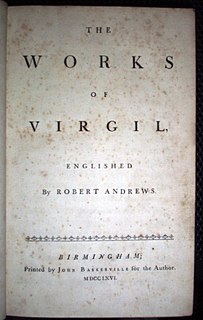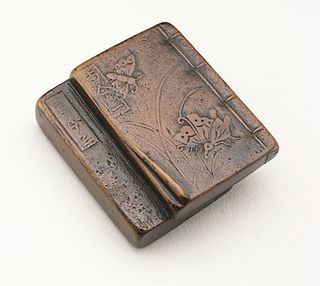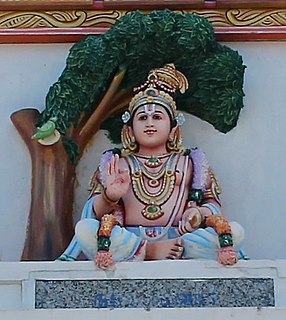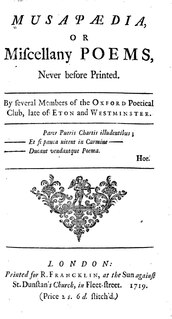
Haiku is a type of short form poetry originally from Japan. Traditional Japanese haiku consist of three phrases that contain a kireji, or "cutting word", 17 on in a 5, 7, 5 pattern, and a kigo, or seasonal reference. However, modern haiku vary widely on how closely they follow these traditional elements.

Lyric poetry is a formal type of poetry which expresses personal emotions or feelings, typically spoken in the first person. It is not equivalent to song lyrics, though they are often in the lyric mode. The term derives from a form of Ancient Greek literature, the lyric, which was defined by its musical accompaniment, usually on a stringed instrument known as a lyre. The term owes its importance in literary theory to the division developed by Aristotle between three broad categories of poetry: lyrical, dramatic, and epic.

Imagism was a movement in early-20th-century Anglo-American poetry that favored precision of imagery and clear, sharp language. It has been described as the most influential movement in English poetry since the Pre-Raphaelites. As a poetic style it gave modernism its start in the early 20th century, and is considered to be the first organized modernist literary movement in the English language. Imagism is sometimes viewed as "a succession of creative moments" rather than a continuous or sustained period of development. René Taupin remarked that "it is more accurate to consider Imagism not as a doctrine, nor even as a poetic school, but as the association of a few poets who were for a certain time in agreement on a small number of important principles".

This article focuses on poetry from the United Kingdom written in the English language. The article does not cover poetry from other countries where the English language is spoken, including Southern Ireland after December 1922.
Prose poetry is poetry written in prose form instead of verse form, while preserving poetic qualities such as heightened imagery, parataxis, and emotional effects.
Canadian poetry is poetry of or typical of Canada. The term encompasses poetry written in Canada or by Canadian people in the official languages of English and French, and an increasingly prominent body of work in Indigenous languages.

The Greek Anthology is a collection of poems, mostly epigrams, that span the Classical and Byzantine periods of Greek literature. Most of the material of the Greek Anthology comes from two manuscripts, the Palatine Anthology of the 10th century and the Anthology of Planudes of the 14th century.

Blank verse is poetry written with regular metrical but unrhymed lines, almost always in iambic pentameter. It has been described as "probably the most common and influential form that English poetry has taken since the 16th century", and Paul Fussell has estimated that "about three quarters of all English poetry is in blank verse".
In book publishing, an anthology is a collection of literary works chosen by the compiler; it may be a collection of plays, poems, short stories, songs or excerpts by different authors. In genre fiction, the term "anthology" typically categorizes collections of shorter works such as short stories and short novels, by different authors, each featuring unrelated casts of characters and settings, and usually collected into a single volume for publication. Alternatively, it can also be a collection of selected writings by one author.

Japanese poetry is poetry typical of Japan, or written, spoken, or chanted in the Japanese language, which includes Old Japanese, Early Middle Japanese, Late Middle Japanese, and Modern Japanese, as well as poetry in Japan which was written in the Chinese language or ryūka from the Okinawa Islands: it is possible to make a more accurate distinction between Japanese poetry written in Japan or by Japanese people in other languages versus that written in the Japanese language by speaking of Japanese-language poetry. Much of the literary record of Japanese poetry begins when Japanese poets encountered Chinese poetry during the Tang dynasty. Under the influence of the Chinese poets of this era Japanese began to compose poetry in Chinese kanshi); and, as part of this tradition, poetry in Japan tended to be intimately associated with pictorial painting, partly because of the influence of Chinese arts, and the tradition of the use of ink and brush for both writing and drawing. It took several hundred years to digest the foreign impact and make it an integral part of Japanese culture and to merge this kanshi poetry into a Japanese language literary tradition, and then later to develop the diversity of unique poetic forms of native poetry, such as waka, haikai, and other more Japanese poetic specialties. For example, in the Tale of Genji both kanshi and waka are frequently mentioned. The history of Japanese poetry goes from an early semi-historical/mythological phase, through the early Old Japanese literature inclusions, just before the Nara period, the Nara period itself, the Heian period, the Kamakura period, and so on, up through the poetically important Edo period and modern times; however, the history of poetry often is different from socio-political history.

The Nalayira Divya Prabandham is a collection of 4,000 Tamil verses composed by the 12 Alvars, and was compiled in its present form by Nathamuni during the 9th – 10th centuries. The work, an important liturgical compilation of the Tamil Alvars, marks the beginning of the canonization of 12 Vaishnava poet saints, and these hymns are still sung extensively today. The works were lost before they were collected and organized in the form of an anthology by Nathamuni.
Renku, or haikai no renga, is a Japanese form of popular collaborative linked verse poetry. It is a development of the older Japanese poetic tradition of ushin renga, or orthodox collaborative linked verse. At renku gatherings participating poets take turns providing alternating verses of 17 and 14 morae. Initially haikai no renga distinguished itself through vulgarity and coarseness of wit, before growing into a legitimate artistic tradition, and eventually giving birth to the haiku form of Japanese poetry. The term renku gained currency after 1904, when Kyoshi Takahama started to use it.
Patiṟṟuppattu is a classical Tamil poetic work and one of the Eight Anthologies (Ettuthokai) in the Sangam literature. It is a panegyric collection that exclusively contains puram category of Sangam poems.The God Vishnu is the centre of this work and is refereed to as Thirumal who holds the disk and the conch. The invocatory poem is on Krishna
Nijaguna Shivayogi was an Indian poet and a prolific writer in the Kannada language. He lived in the 15th century. He was a follower of the Veerashaiva faith, which he attempted to reconcile with the Advaita Hinduism of Adi Shankaracharya. Tradition has it that Shivayogi was a petty chieftain of Kollegal taluk in modern Mysore district of Karnataka state, India. Considered a visionary of his time, his Vivekachintamani, written in encyclopaedic proportions and in prose style, and the Kaivalya Paddhati, a musical treatise consisting of songs are considered his most enduring works.

Jagannatha Dasa (1728–1809), a native of Manvi town in the Raichur district, Karnataka state, India, is considered one of the notable Haridasa saint-poets of the Kannada language. Apart from authoring numerous well-known devotional songs that propagate the Vaishnava bhakti ("faith"), Jagannatha Dasa wrote the Harikathamritasara in the native shatpadi metre and Tattva suvali in the native tripadi metre. He was also an accomplished scholar in the Sanskrit language.

A miscellany is a collection of various pieces of writing by different authors. Meaning a mixture, medley, or assortment, a miscellany can include pieces on many subjects and in a variety of different forms. In contrast to anthologies, whose aim is to give a selective and canonical view of literature, miscellanies were produced for the entertainment of a contemporary audience and so instead emphasise collectiveness and popularity. Laura Mandell and Rita Raley state:
This last distinction is quite often visible in the basic categorical differences between anthologies on the one hand, and all other types of collections on the other, for it is in the one that we read poems of excellence, the "best of English poetry," and it is in the other that we read poems of interest. Out of the differences between a principle of selection and a principle of collection, then, comes a difference in aesthetic value, which is precisely what is at issue in the debates over the "proper" material for inclusion into the canon.
A subhashita is a literary genre of Sanskrit epigrammatic poems and their message is an aphorism, maxim, advice, fact, truth, lesson or riddle. Su in Sanskrit means good; bhashita means spoken; which together literally means well spoken or eloquent saying.
Sharngadhara-paddhati is an anthology of Sanskrit-language short poems (subhashita) from India. It was compiled by Sharngadhara in 1363.
Duncan Livingstone (Donnchadh MacDhunléibhe was a Scottish Gaelic Bard from the Isle of Mull, who lived most of his life in South Africa.









